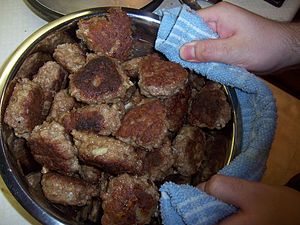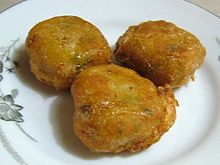Frikadelle: Difference between revisions
Removed references to other countries. The article indicated that the frikadeller as a dish spread from denmark and affected other european countries. Not only is that sourceless but obviously nonsense. I got no problem with a wiki article about danish meatballs but keep misinformation about other countries cuisine out of it and stick to the facts. |
Snowstormer (talk | contribs) No edit summary |
||
| Line 17: | Line 17: | ||
}} |
}} |
||
'''Frikadeller''' are flat, pan-fried [[meatballs]] of minced meat, often likened to the [[Denmark|Danish]] version of [[meatball]]s. The origin of the dish is unknown but frikadeller are most often associated with [[Danish cuisine]] specifically or |
'''Frikadeller''' are flat, pan-fried [[meatballs]] of minced meat, often likened to the [[Denmark|Danish]] version of [[meatball]]s. The origin of the dish is unknown but frikadeller are most often associated with [[Danish cuisine]] specifically or Scandinavian cuisine in general. Through cultural exchange, frikadeller have also entered national cuisines of other European countries, such as the [[Faroe Islands]] and [[Norway]].{{citation needed}} |
||
There are various local variants of frikadeller throughout Scandinavia, as both a [[main course]] and a [[side dish]]. In [[Sweden]], poached [[quenelle]]s are called "frikadeller". |
There are various local variants of frikadeller throughout Scandinavia, as both a [[main course]] and a [[side dish]]. In [[Sweden]], poached [[quenelle]]s are called "frikadeller". |
||
Revision as of 18:47, 15 February 2019
This article includes a list of general references, but it lacks sufficient corresponding inline citations. (September 2015) |
 A freshly made batch of frikadeller | |
| Place of origin | Uncertain; supposedly Denmark or Germany |
|---|---|
| Serving temperature | Hot or cold |
| Main ingredients | Pork, veal, lamb, beef or fish |
| Other information | As a main dish, generally served with boiled potatoes and gravy, or creamed cabbage |
Frikadeller are flat, pan-fried meatballs of minced meat, often likened to the Danish version of meatballs. The origin of the dish is unknown but frikadeller are most often associated with Danish cuisine specifically or Scandinavian cuisine in general. Through cultural exchange, frikadeller have also entered national cuisines of other European countries, such as the Faroe Islands and Norway.[citation needed]
There are various local variants of frikadeller throughout Scandinavia, as both a main course and a side dish. In Sweden, poached quenelles are called "frikadeller".
Etymology
The origin of the word is uncertain. According to the Etymologisches Wörterbuch des Deutschen, it can be found end of the 17th century in German, and is related to the Italian 'frittatella', French 'fricandeau', and Latin 'frīgere' (roast).[1] It may be derived from fricandeau de veau, a dish of sliced veal, larded with pork fat.[2] In the Dictionnaire des dictionnaires (1837) 'fricadelle' is defined as, "In Belgium, a ball of minced, cooked meat" and a separate word, 'fricadèle', is defined as "fricandeau".[3] And in Phillips's New World of Words (1706) "Fricandoe, a sort of Scotch Collops made of thin slices of Veal, well larded and stuff'd." The Oxford English Dictionary defines 'fricandele' (variation 'fricadelle") as a "quasi-French form of fricandeau".[4]
Other variations

Frikadel are also known in Indonesian cuisine through Dutch cuisine (of the frikadel, which is historically similar to the frikadaller) influence and called perkedel, however the main ingredient is not meat, but mashed potato, sometimes slightly mixed with ground meat or corned beef. The mixture is then shaped into flat round patties and dipped in egg yolk before being deep fried. Other than mashed potato, cabe rawit, spring onion, shrimp, peeled corn, or mashed tofu fritters are also common as perkedel ingredients.
In Denmark, traditionally, they are made from minced veal, pork or beef (or a blend of two of these meats); chopped onions; eggs; milk (or water); bread crumbs (or oatmeal or flour); salt; and pepper; then formed into balls and flattened somewhat. They are then pan-fried in pork fat or beef fat, or more commonly in modern times in butter, margarine or even vegetable oil. Another popular variation is fiskefrikadeller replacing the meat with fish as the main ingredient and often served with remoulade.
As a main dish they are most often served with boiled white potatoes and gravy (brun sovs) accompanied by pickled beetroot or cooked red cabbage. Alternatively they can be served with creamed, white cabbage.
Frikadeller are also eaten on rugbrød with red cabbage or pickle slices as a traditional Danish smørrebrød
The combination of frikadeller and a cold potato salad is very popular at picnics or potlucks, due to the ease of transporting either component after cooking.
See also
- Frikkadel
- Frikandel, a Dutch minced-meat hot dog
- Hamburg steak
- Perkedel
- Meatball
- Cuisine of Denmark
- Cuisine of Germany
- South African cuisine
- Skilpadjies
- Dry meatballs
- Tteok-galbi
References
- ^ "Frikadelle". www.dwds.de. Berlin-Brandenburg Academy of Sciences and Humanities. Retrieved 2017-01-11.
- ^ Éric Boschman; Nathalie Derny (2008) "La Fricadelle", Le Goût des Belges, vol. 2, p. 33, Éditions Racine ISBN 978-2-87386-525-2 Template:Fr icon
- ^ Delcourt-Angélique, Janine; Delcourt, Christian (2006). "Georges Simenon et le français de Belgique". Revue belge de philologie et d'histoire (in French). 84: 808. Retrieved 28 March 2014.
- ^ Oxford English Dictionary (2003)
